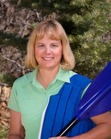Beth Groundwater's Blog, page 6
December 18, 2013
Today's Mystery Author Guest: Catherine Dilts
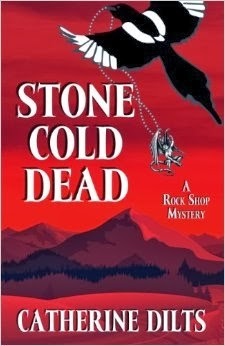
As promised yesterday, fellow Colorado mystery author Catherine Dilts is visiting my blog today, with answers to my interview questions. To read her bio and see her photo, please page down to yesterday's post. Also, Catherine is running a contest for a free autographed ARC (advanced review copy) of her upcoming January release, Stone Cold Dead, the cover art for which appears above. Catherine will select the winner tomorrow evening from among those who leave a comment today or tomorrow and will announce the name in a comment on this post.
In the book, business at the Rock of Ages is as dead as the fossils cluttering the shop’s dusty shelves. When her brother abandons the family rock shop, recently widowed Morgan Iverson reluctantly becomes the manager. Her first day in charge, two pet donkeys escape. While rounding them up, Morgan discovers the body of a Goth teen. When a newspaper article hits the streets hinting that Morgan witnessed the murder, she becomes the victim of escalating threats that make it clear the killer thinks she holds a clue to the teen’s murder. Morgan knows her life won’t be worth a pile of fossilized dinosaur dung unless she can dig up the murderer.
Sounds like a fun and fascinating read to me! Below are Catherine's answers to my interview questions.
1. Who or what inspired you to start writing and when did you start?
Boredom was my original inspiration. When I was a child, my family spent a portion of our summers visiting relatives in South Dakota. This was back in the dark ages, before cable TV, personal computers, and the Internet. On rainy days, when we couldn’t play in the lake or explore corn fields, my siblings and I would write plays and perform them for our indulgent aunts and uncles during their daily “happy hour.” We believed it was our talent that sent them into gales of laughter, but I suspect the alcohol didn’t hurt.
2. What tools and process do you use to “get to know” your characters before and while you’re writing the books?
Typically, I have an initial flash of inspiration as I see a character in a situation, possibly uttering a line that defines his or her world view. In Stone Cold Dead, Del Addison says “You hear about it every winter… Some flatlander heads out unprepared. They don’t get found until a hiker sees their frozen body in a snowbank come springtime.” After they introduce themselves to me, they develop as the story progresses. Some characters are born in my imagination whole, while others fight to let me know, “I wouldn’t do that!”
3. How do you construct your plots? Do you outline or do you write “by the seat of your pants”?
I am definitely a Plotter. However, my carefully constructed outlines and timelines always change, sometimes dramatically. I have to have a road map, but I’m not opposed to veering off-road if it takes me where I need to go.
4. In the age-old question of character versus plot, which one do you think is most important in a murder mystery and which one do you emphasize in your writing? Why?
Character, definitely. Jeffery Deaver spends months devising his convoluted plots, but what engages the reader, in my opinion, is his character Lincoln Rhyme. I believe I’ve had some unique experiences in my life, and met some genuine characters. I like to introduce readers to people they may not have met in real life. Oh, plot is essential in a mystery, but without engaging characters, who will care about who done it?
5. What is the biggest challenge you’ve faced as a writer and what inspires you and keeps you motivated?
Letting go of my fears. Fear of offending someone. Fear of exposing myself emotionally. Killing that self-censoring editor inside my head that destroys every creative impulse. My inspiration is my family, who supported and encouraged my dream of being an author even when it seemed impossible.
6. What is a typical workday for you and how many hours a day (or week) do you devote to writing?
Defending the planet by day, plotting murder by night. That’s my life in an organically grown nutshell. I have a day job as an environmental scientist, which sounds exciting, but actually involves mostly regulatory paperwork. I squeeze in fiction writing by getting up early and writing for 15, 30, or maybe 60 minutes before heading to work. When I get home, I might get another 2 or 3 hours in on a good day. I average 30 to 40 hours of straight fiction writing a month. It’s not enough, but it’s what I can manage for now.
7. What advice do you have to offer to an aspiring author?
Don’t. Not unless you have to. It’s an ego-busting business with little financial reward. Take up bowling instead. How do you know if you have to write? Quit for a week. You’ll know. If you are truly a writer, you’ll sacrifice leisure time, social events, sleep, and maybe a little sanity, to get words down, to tell a story just right. And you’ll love every frustrating, challenging, triumphant step of the journey.
8. Now here’s a zinger. Tell us something about yourself that you have not revealed in another interview yet. Something as simple as your favorite TV show or food will do.
I have a morbid fear of forklifts.
9. What are you working on now and what are your future writing plans?
I am writing book two in my Rock Shop Mystery series, and polishing a short story involving a forklift.
10. Is there anything else you would like to tell my blog readers?
Thank you for inviting me to your blog, Beth! My novel Stone Cold Dead – A Rock Shop Mystery makes its debut in January, 2014. It is available through Barnes and Noble and Amazon, but if you like supporting independent bookstores, you can find it at the historic Denver Tattered Cover Book Store. I also have short stories appearing in Alfred Hitchcock Mystery Magazine from time to time, which now offers subscriptions for electronic readers like Nook and Kindle. And please visit me at my website!
Thanks, Catherine! Now, who has a comment or question for Catherine Dilts? Good luck in the contest!
Published on December 18, 2013 03:00
December 17, 2013
Tomorrow's Guest: Catherine Dilts
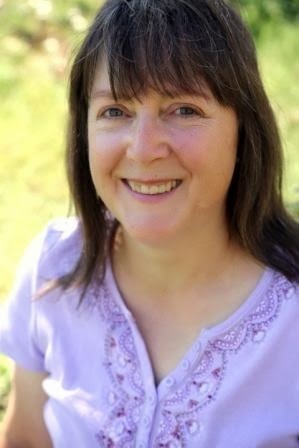
Tomorrow, fellow Colorado mystery author Catherine Dilts will guest on my blog. She answers my interview questions, and I'm sure you'll be intrigued by what he has to say. Also, Catherine will run a contest for an autographed ARC (advanced review copy) of her first mystery release, Stone Cold Dead , which features the manager of a rock shop. She will choose the winner from among those who leave a comment.
To Catherine Dilts, rock shops are like geodes – both contain amazing treasures hidden inside their plain-as-dirt exteriors. Publishers Weekly calls her novel Stone Cold Dead – A Rock Shop Mystery, an “enjoyable debut,” and that “readers will look forward to seeing more of this endearing and strong protagonist.” Catherine works as an environmental scientist, and plays at heirloom vegetable gardening, camping, and fishing. She has published short fiction in Alfred Hitchcock Mystery Magazine . I know Catherine personally, and she's a great gal!
Published on December 17, 2013 03:00
December 16, 2013
The Page 69 Test
Today I'm over at Inkspot, the blog for Midnight Ink authors, talking about The Page 69 Test. Marshall McLuhan, author of The Gutenberg Galaxy, recommends reading page 69 of a novel, and if you like that page, buying the book. I posted Page 69 of both of my 2013 releases (
Fatal Descent
and
A Basket of Trouble
) to try out the strategy. Would you keep reading after those excerpts? Will you buy the books? And what do you think of the strategy? Is the Page 69 Test a valid way to make your reading choices? Leave a comment there, and let me know what you think.
Published on December 16, 2013 03:00
December 13, 2013
Japan Trip Report - Part Five
This is the fifth of a series of trip reports about my husband Neil's and my trip to Japan on an Overseas Adventure Travel tour in October. Page down to read the other four, and stay tuned for more. I have a guest mystery author next week, then I will resume the trip reports on Monday, December 23rd, with our last location, Kyoto.
On October 24th, we took a chartered coach to the mountain villages of Shirakawa-go and Gokayama to see their distinct gassho-zukuri farmhouses characterized by steeply pitched thatched roofs (first photo below). At a visitor center there, we learned to make mochi (pounded rice--see me pounding in the second photo), which the staff shaped into balls and served to us with sweet red beans (third photo). Later in the trip, I bought sweets made from mochi stuffed with chestnut or sweet potato paste.
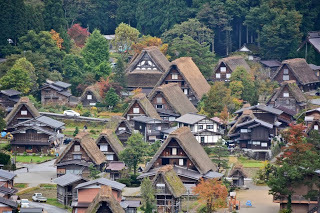
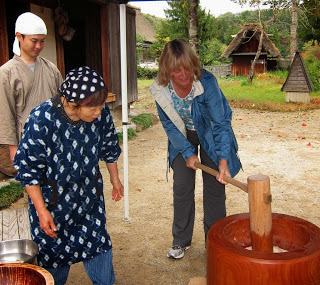
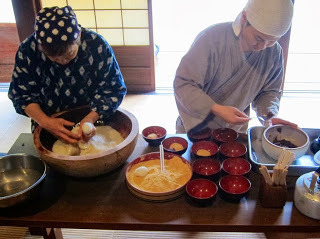
Next we visited Murakami House (first photo below), which was built in 1578 and is the oldest ghasso-style house in the area. There, we watched a traditional Kokuriko dance performance (second photo). The dancer is playing a sasara percussion instrument that is made out of 108 cypress plates
joined together. Then we looked over the collection of historical farm implements and tools in the large attic (third photo). After that we lunched at a soba (buckwheat noodles) restaurant (fourth photo) before saying goodbye to Gokayama and its arch shaped like a sasara (last photo).
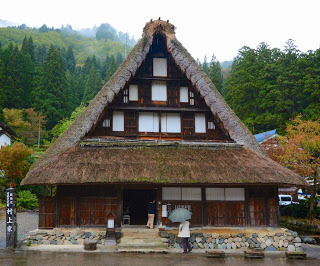
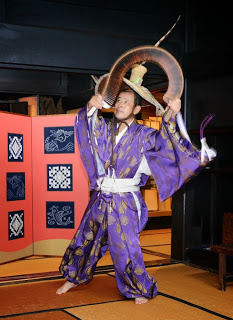
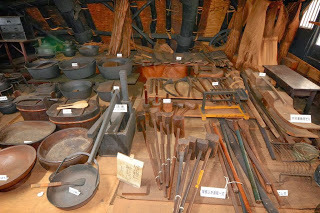
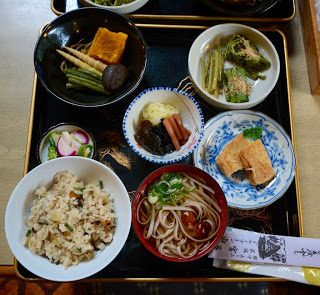
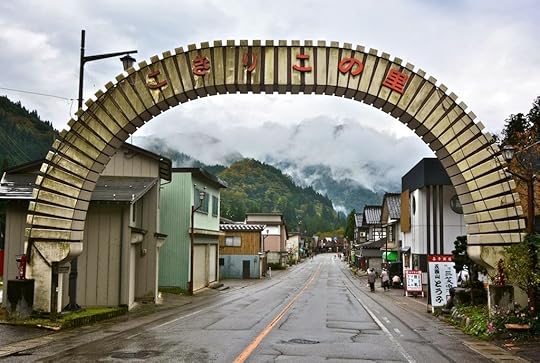
After lunch, we journeyed to a paper-making workshop to try our hand at making washi—a thick, fibrous paper made from mulberry bark. After dipping forms in a water bath of mulberry fibers (first photo below), and decorating our paper with some flowers, the staff finished off the sheets with a final coat, sucked the water out of the forms with what was basically a giant vacuum cleaner, then hung the sheets to dry (second photo). We took them home with us as a souvenir. After returning to Kanazawa, we went to the top floor of a department store (third photo) to eat dinner in one of the restaurants there.
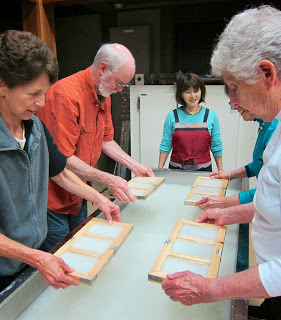
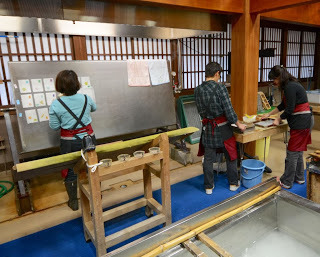
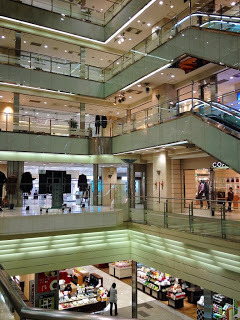
The next day, October 25th, we divided up to visit with local Japanese residents in their homes. Neil and I visited a gracious lady who dressed us up in kimonos for a photo (first photo below), served us tea, played her koto stringed instrument for us (second photo), and showed us her home, including a home altar (third and fourth photos). We managed to communicate with a few words, some hand signals and pointing to pictures in a child's English book, since her English was limited and our Japanese was nonexistent. We spent a happy hour and a half visiting with her, even with the language difficulties, and showed each other family photos.
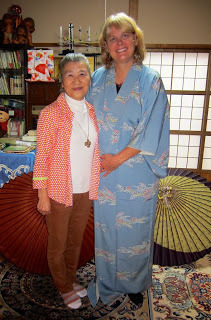
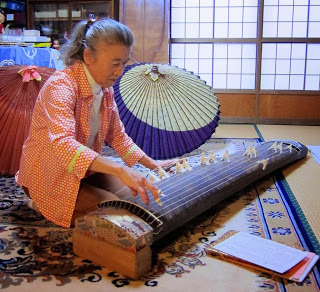
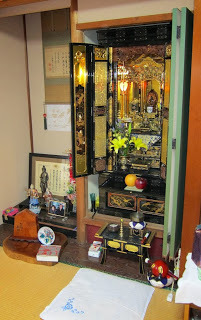
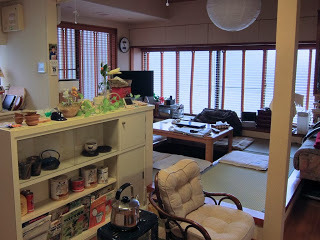
Then we shopped in a department store's food basement (first photo below) for meats on sticks (second photo) and a bento box of salads that became our lunch on the train to Kyoto. The third photo is the Kanazawa train station, the fourth is the train, and the last three are of the monstrous Kyoto train station.
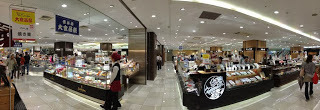
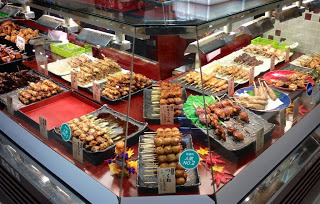
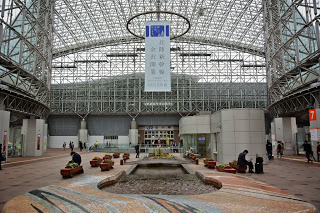
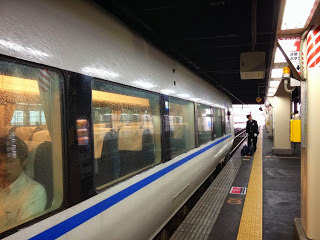
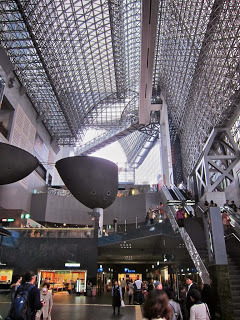
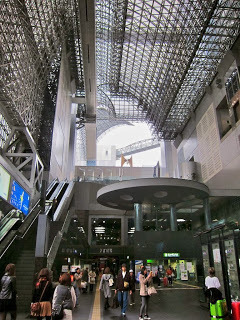
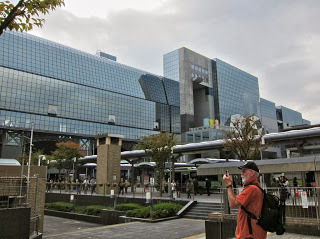
After arriving in Kyoto in the late afternoon, we checked into the Aranvert Hotel. Kyoto was phenomenal, so don't miss checking back in for the final set of photos from there!
On October 24th, we took a chartered coach to the mountain villages of Shirakawa-go and Gokayama to see their distinct gassho-zukuri farmhouses characterized by steeply pitched thatched roofs (first photo below). At a visitor center there, we learned to make mochi (pounded rice--see me pounding in the second photo), which the staff shaped into balls and served to us with sweet red beans (third photo). Later in the trip, I bought sweets made from mochi stuffed with chestnut or sweet potato paste.



Next we visited Murakami House (first photo below), which was built in 1578 and is the oldest ghasso-style house in the area. There, we watched a traditional Kokuriko dance performance (second photo). The dancer is playing a sasara percussion instrument that is made out of 108 cypress plates
joined together. Then we looked over the collection of historical farm implements and tools in the large attic (third photo). After that we lunched at a soba (buckwheat noodles) restaurant (fourth photo) before saying goodbye to Gokayama and its arch shaped like a sasara (last photo).





After lunch, we journeyed to a paper-making workshop to try our hand at making washi—a thick, fibrous paper made from mulberry bark. After dipping forms in a water bath of mulberry fibers (first photo below), and decorating our paper with some flowers, the staff finished off the sheets with a final coat, sucked the water out of the forms with what was basically a giant vacuum cleaner, then hung the sheets to dry (second photo). We took them home with us as a souvenir. After returning to Kanazawa, we went to the top floor of a department store (third photo) to eat dinner in one of the restaurants there.



The next day, October 25th, we divided up to visit with local Japanese residents in their homes. Neil and I visited a gracious lady who dressed us up in kimonos for a photo (first photo below), served us tea, played her koto stringed instrument for us (second photo), and showed us her home, including a home altar (third and fourth photos). We managed to communicate with a few words, some hand signals and pointing to pictures in a child's English book, since her English was limited and our Japanese was nonexistent. We spent a happy hour and a half visiting with her, even with the language difficulties, and showed each other family photos.




Then we shopped in a department store's food basement (first photo below) for meats on sticks (second photo) and a bento box of salads that became our lunch on the train to Kyoto. The third photo is the Kanazawa train station, the fourth is the train, and the last three are of the monstrous Kyoto train station.







After arriving in Kyoto in the late afternoon, we checked into the Aranvert Hotel. Kyoto was phenomenal, so don't miss checking back in for the final set of photos from there!
Published on December 13, 2013 03:00
December 11, 2013
Japan Trip Report - Part Four
This is the fourth of a series of trip reports about my husband Neil's and my trip to Japan on an Overseas Adventure Travel tour in October. Page down to read the other three, and stay tuned for more! I'm up to October 22nd, when we left Hakone to travel via the Shinkasen Bullet Train to Kanazawa (two photos below--note the speed of 165 mph on the GPS!), which gave us the opportunity to sample bento boxes (third photo below) for lunch.
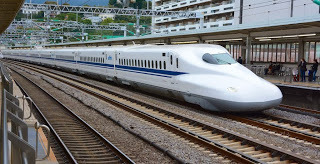

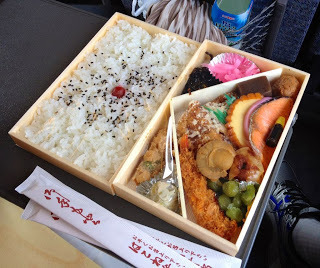
After arriving in Kanazawa, we checked into the Kanazawa Excel Hotel Tokyu and observed an employee fire drill taking place below our room. That evening we went on a walking tour of the city's canals and nearby historical samurai house district before dining out.
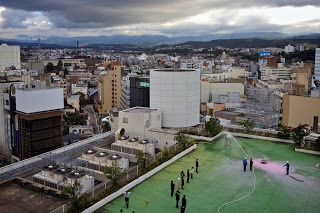
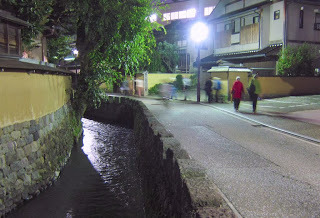
The next day, October 23rd, was a jam-packed tour of Kanazawa, often called "little Kyoto," because like Kyoto, it is a culturally rich city that escaped bombing in World War II, so many of its Edo-era buildings are still surviving. We started at the beautiful Kenrokuen Garden, one of the Three Great Gardens of Japan. The views were stunning, as you can see in the photos below. We also toured the Ishikawa Prefectural Museum of Traditional Arts and Crafts nearby.
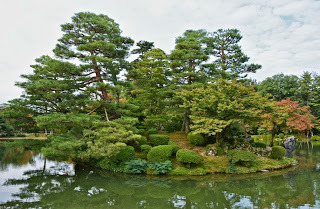


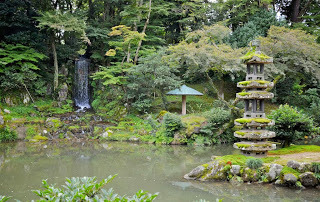
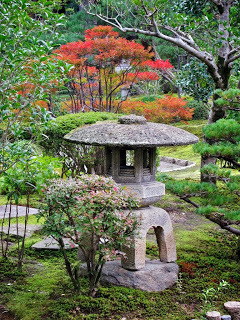
Next we toured the Higashi-Chaya District (first photo below), one of three historic entertainment districts in Kanazawa that featured teahouses where Geishas sang, played instruments, recited poetry, and danced for customers. We toured one of those old wooden teahouses, shown behind our guide Michiko in the second photo. The next two photos show some of the traditional musical instruments and the kitchen inside.

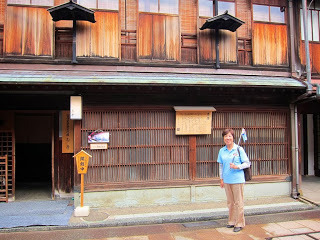
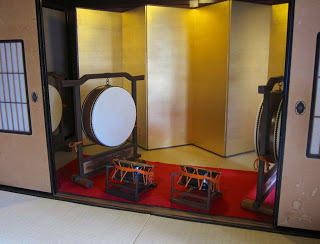
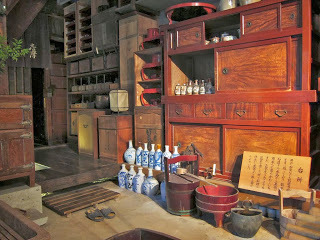
The next stop was the Sakuda shop, where we saw the ancient process of kinpaku, the making of super-thin squares of gold leaf (first photo below), and some of the resulting gold leaf-covered artwork for sale (next two photos below). That was followed by lunch in a French restaurant that featured a custard with gold leaf flakes for dessert (last photo below).
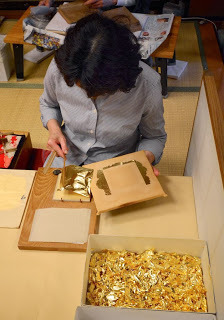
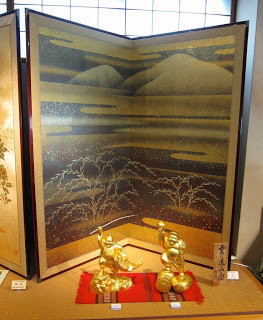
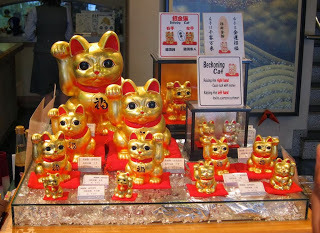
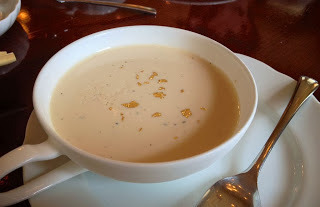
Then we toured the Omicho Market (the entrance of which is shown in the first photo below), with its vegetable (second photo) and seafood (third photo) vendors, among other purveyors.
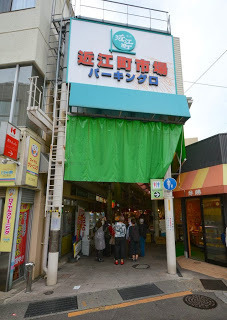
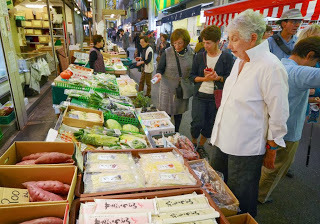
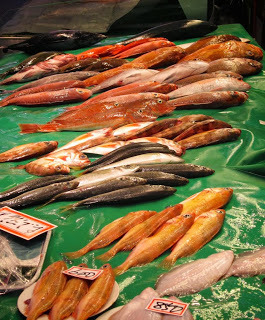
Next stop was a Kutani Ware porcelain factory, where the owner showed us a display of many generations of porcelain produced on site (first photo below), gave us a tour of the factory (second photo) and demonstrated his skill on the potter's wheel (third photo).
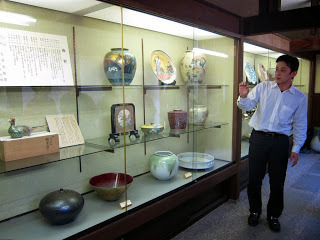
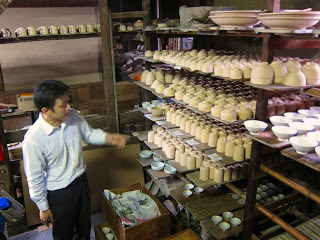
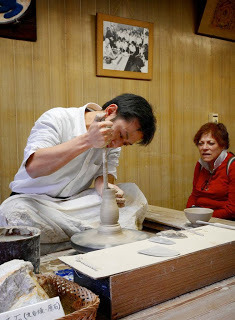
Dinner that night was at a sushi conveyor-belt restaurant (first photo below), where we pulled plates of interesting-looking sushi off the belt (second photo) to eat, followed by black sesame seed ice cream for dessert (third photo).
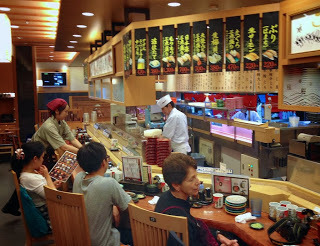
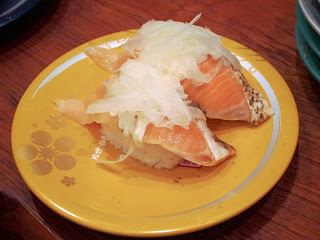
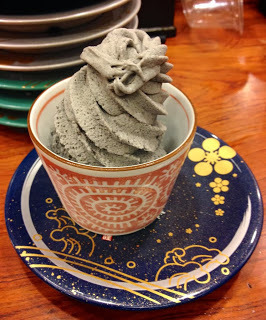



After arriving in Kanazawa, we checked into the Kanazawa Excel Hotel Tokyu and observed an employee fire drill taking place below our room. That evening we went on a walking tour of the city's canals and nearby historical samurai house district before dining out.


The next day, October 23rd, was a jam-packed tour of Kanazawa, often called "little Kyoto," because like Kyoto, it is a culturally rich city that escaped bombing in World War II, so many of its Edo-era buildings are still surviving. We started at the beautiful Kenrokuen Garden, one of the Three Great Gardens of Japan. The views were stunning, as you can see in the photos below. We also toured the Ishikawa Prefectural Museum of Traditional Arts and Crafts nearby.





Next we toured the Higashi-Chaya District (first photo below), one of three historic entertainment districts in Kanazawa that featured teahouses where Geishas sang, played instruments, recited poetry, and danced for customers. We toured one of those old wooden teahouses, shown behind our guide Michiko in the second photo. The next two photos show some of the traditional musical instruments and the kitchen inside.




The next stop was the Sakuda shop, where we saw the ancient process of kinpaku, the making of super-thin squares of gold leaf (first photo below), and some of the resulting gold leaf-covered artwork for sale (next two photos below). That was followed by lunch in a French restaurant that featured a custard with gold leaf flakes for dessert (last photo below).




Then we toured the Omicho Market (the entrance of which is shown in the first photo below), with its vegetable (second photo) and seafood (third photo) vendors, among other purveyors.



Next stop was a Kutani Ware porcelain factory, where the owner showed us a display of many generations of porcelain produced on site (first photo below), gave us a tour of the factory (second photo) and demonstrated his skill on the potter's wheel (third photo).



Dinner that night was at a sushi conveyor-belt restaurant (first photo below), where we pulled plates of interesting-looking sushi off the belt (second photo) to eat, followed by black sesame seed ice cream for dessert (third photo).



Published on December 11, 2013 03:00
December 9, 2013
Japan Trip Report - Part Three
Last week, I posted the first two of a series of trip reports about my husband Neil's and my trip to Japan on an Overseas Adventure Travel tour in October. I'll continue those posts this week. I'm up to October 20th, the day we traveled to the mountain resort of Hakone. On the way, we stopped at the Kawaguchiko Fifth Station on Mount Fuji, the highest you can go by vehicle before you have to start hiking on foot if you want to reach the top. Unfortunately, because of the second of three typhoons to hit Japan while we were there, it was a very rainy day and we couldn't see the top (photo below).
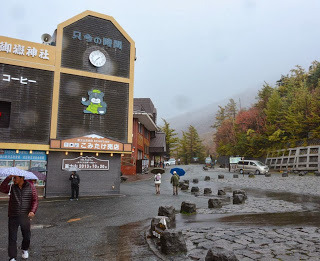
In Hakone, we stayed the Gora Asahi Hotel, a traditional Japanese inn, with rooms with sliding paper walls and tatami mat floors. Below I'm standing in our room's entryway after the futon beds had been laid out by the maid. I'm wearing yukata, an informal kimono that serves much like a bathrobe, and that the guests wore to dinner and the onsen, the hot public bath area. The next two photos show our group at dinner and just the appetizers from our delicious gourmet meal.
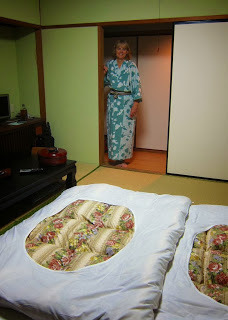
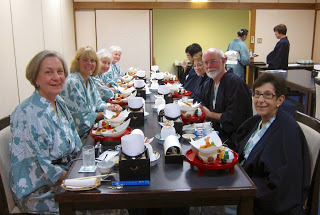
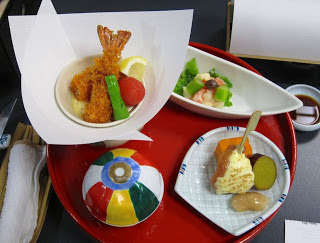
The next day, October 21st, we rode in a bus to Mount Soun, where we took an aerial gondola (first photo below) to the thermal springs in the Owakudani Valley (second photo below). There we ate blackened eggs that were boiled in one of Owakudani’s bubbling lava pools (last two photos below).
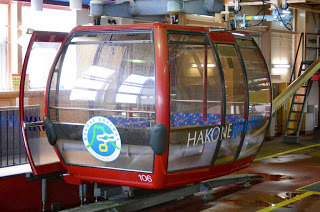
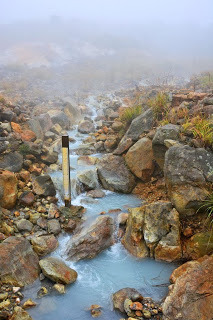
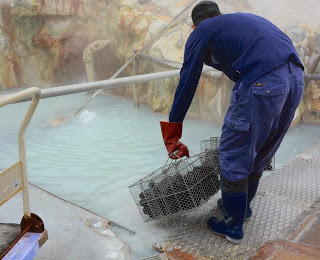
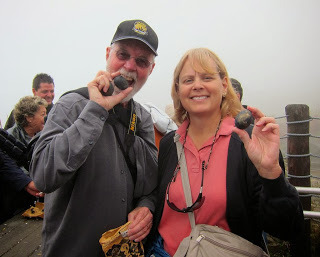
Then, we cruised Lake Ashi from Kojiri to Hakone-machi in the boat shown in the first photo below. The lake formed in a crater in the wall of the huge caldera of the Mount Hakone volcano. From the boat, we could see the torii gate for the Hakone Shinto Shrine in the water (second photo).
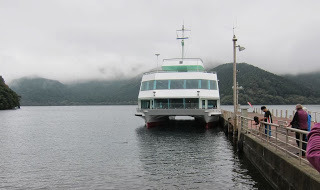
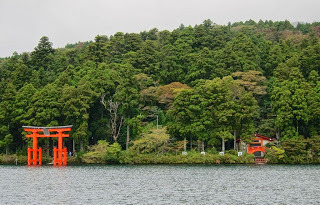
After getting off the boat, we ate a scrumptious buffet lunch at a local restaurant. Then we walked a section of the cedar-lined path of the Old Tōkaidō Road, the most important of the Five Routes of the Edo period (two photos below).
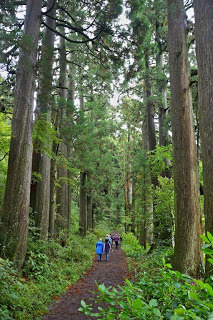
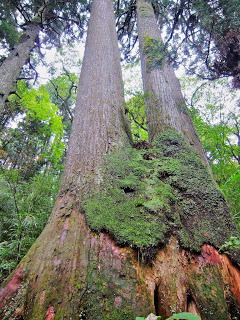
The next stop was the Hakone Yosegi Zaiku shop (first photo below) of a fourth-generation artisan woodmaker of traditional Japanese parquetry (second photo). He creates objects and works of art from pieces of differently-colored wood fused together (third photo).
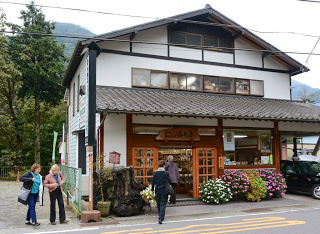

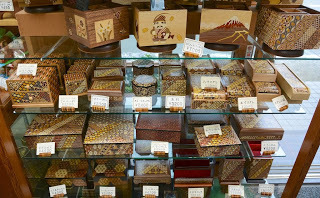
Our final sightseeing stop of a very busy day was the extraordinary Hakone Open Air Museum with its large variety of sculptures collected from around the world. Enjoy a select few of them below.
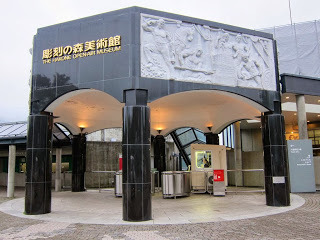
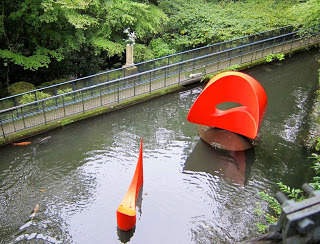
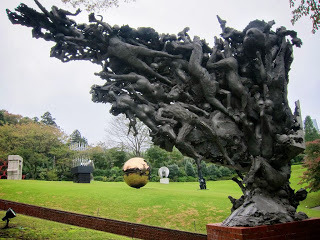
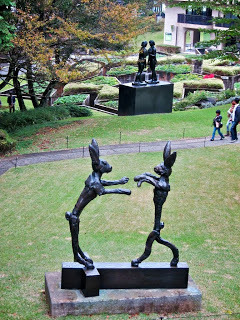
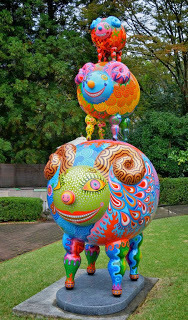
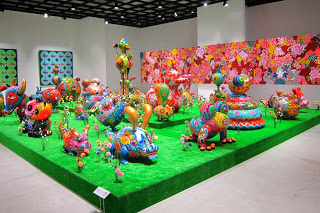

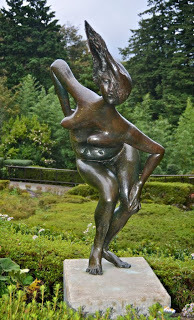
The tower below was constructed of stained glass panels, shown from inside the tower in the second photo below.
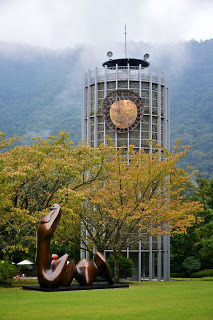
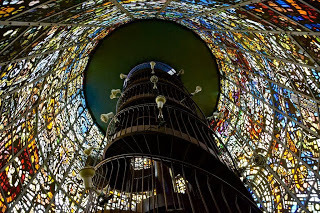
After one more scrumptious Japanese dinner at the hotel, we returned to our rooms to pack for our morning departure the next day to Kanazawa.
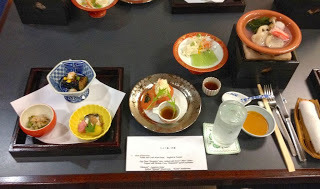

In Hakone, we stayed the Gora Asahi Hotel, a traditional Japanese inn, with rooms with sliding paper walls and tatami mat floors. Below I'm standing in our room's entryway after the futon beds had been laid out by the maid. I'm wearing yukata, an informal kimono that serves much like a bathrobe, and that the guests wore to dinner and the onsen, the hot public bath area. The next two photos show our group at dinner and just the appetizers from our delicious gourmet meal.



The next day, October 21st, we rode in a bus to Mount Soun, where we took an aerial gondola (first photo below) to the thermal springs in the Owakudani Valley (second photo below). There we ate blackened eggs that were boiled in one of Owakudani’s bubbling lava pools (last two photos below).




Then, we cruised Lake Ashi from Kojiri to Hakone-machi in the boat shown in the first photo below. The lake formed in a crater in the wall of the huge caldera of the Mount Hakone volcano. From the boat, we could see the torii gate for the Hakone Shinto Shrine in the water (second photo).


After getting off the boat, we ate a scrumptious buffet lunch at a local restaurant. Then we walked a section of the cedar-lined path of the Old Tōkaidō Road, the most important of the Five Routes of the Edo period (two photos below).


The next stop was the Hakone Yosegi Zaiku shop (first photo below) of a fourth-generation artisan woodmaker of traditional Japanese parquetry (second photo). He creates objects and works of art from pieces of differently-colored wood fused together (third photo).



Our final sightseeing stop of a very busy day was the extraordinary Hakone Open Air Museum with its large variety of sculptures collected from around the world. Enjoy a select few of them below.








The tower below was constructed of stained glass panels, shown from inside the tower in the second photo below.


After one more scrumptious Japanese dinner at the hotel, we returned to our rooms to pack for our morning departure the next day to Kanazawa.

Published on December 09, 2013 03:00
December 6, 2013
Japan Trip Report - Part Two
As I wrote yesterday, my husband Neil and I traveled to Japan in October on an Overseas Adventure Travel tour. This week and next, I am posting reports on my blog that each summarize a few days of our two and a half week adventure. This is the second report.
On October 18th, we visited the famous Tsukiji Wholesale Seafood Market in Tokyo (first three photos below), then had a brunch of very fresh sushi in a restaurant right next door (last photo below).
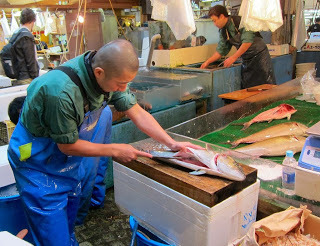
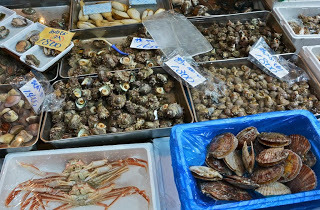
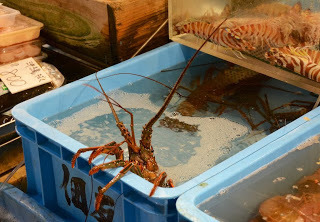
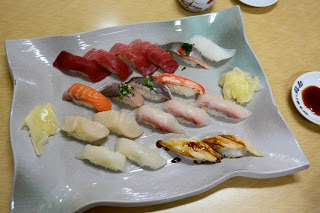
Next we toured the Hama Detached Palace Garden, also called Hamarikyu, (first photo) with its Nakajima teahouse (second photo), a beautiful Eden in the center of Tokyo.
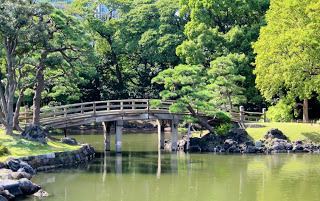
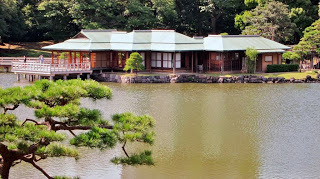
Then we headed for the Ginza district, famous for its high-class shops, such as pearl purveyor Mikimoto (first photo below) and ate a late lunch in a restaurant at the top floor of an interesting building (second photo) with round balconies at each level.
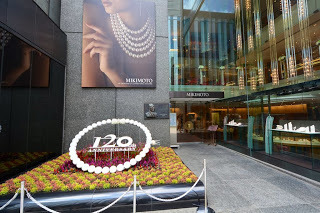
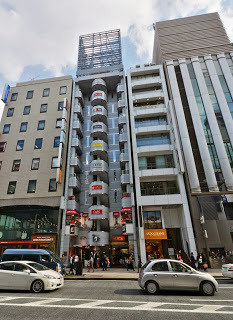
Next stop was the Kabuki-za Theater. It, like most of the temples, shrines, and other monuments we saw, had a display of sake (rice wine) barrels outside (first photo below), representing donations from sake breweries. We saw one act of an all-day, 9-act Kabuki performance at the theater (last two photos below, exterior and interior). The lively act included a swindle and a battle scene, and we rented headphones that played an English commentary during the performance. Unfortunately, no photos of the performance were allowed.
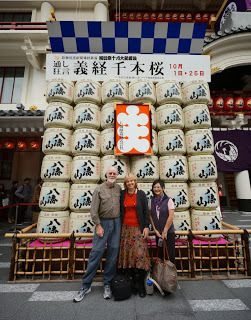
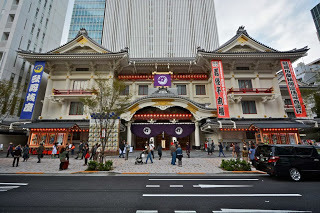
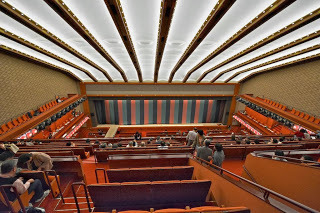
We exited the theater after night had fallen and had our "Lost in Translation" moment (first photo below) while walking through the neon lights of the Ginza district to see the spectacular interior of the Tokyo International Forum (second photo). After dinner in a nearby bakery, we traveled via subway back to the hotel, and it was still crowded with commuters then (last photo).
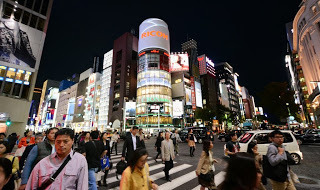
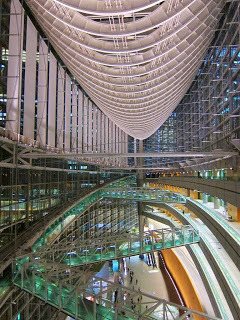
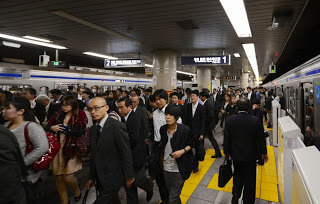
The next day, October 19th, we went to the plaza outside the Tokyo Imperial Palace to see the statue of Kusunoki Masashige (first photo below), a 14th-century samurai who epitomized the ideal of samurai loyalty. Then we took a group photo (second one below, I'm in the blue raincoat) in front of the Nijubashi Bridge that crosses the moat around the palace.
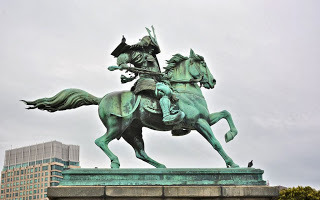
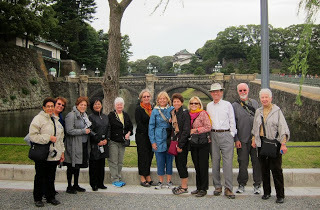
Next we visited Sensō-ji, the Asakusa Kannon Temple (first photo below), and its ornate altar (second photo). The whole complex teemed with people. As at all Buddhist temples, there was a station where worshippers could cleanse themselves (third photo) and another where they could light incense and pray (fourth photo).
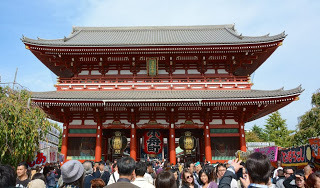
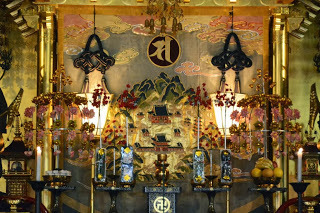
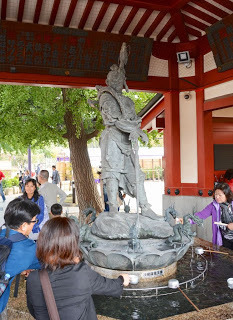
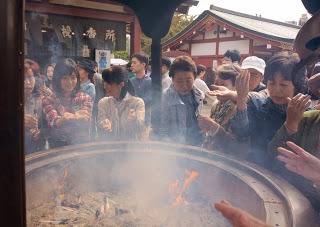
For lunch, our guide took us to the basement food garden of the huge Mitsukoshi department store in the Ginza district, where we shopped for Japanese delicacies, such as salads or Bento boxes (two photos below), to eat for a picnic lunch in the rooftop garden of the store.
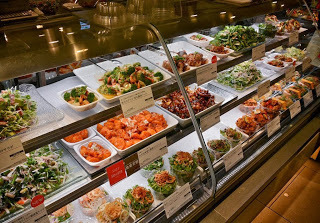
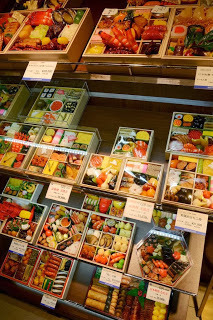
Then we went to Meiji Jingu, a Shinto shrine, with a massive tori gate at its entrance (first photo). All Shinto shrines had torii gates at the entrances. Some were painted red and some were left natural colored, like this one. Since it was Saturday, we were able to observe some children being brought in for blessings at ages of 100 days or 3, 5, or 7 years. They were dressed in traditional clothing, like the girl in the second photo below. Also, we observed wedding parties having photos taken and parading into and out of rooms in the temple where the bridal couple was blessed by a Shinto priest (see last two photos below).
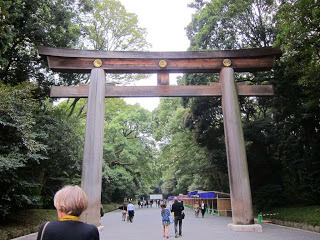
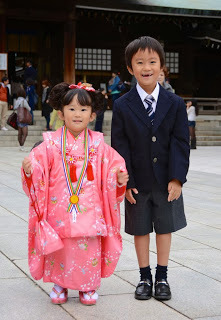
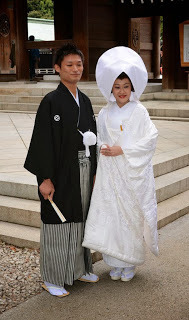
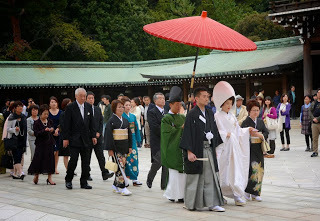
Dinner that night was at a tempura restaurant (two photos below). This was our last day in Tokyo. On October 20th, we left on a bus for the mountain resort of Hakone.

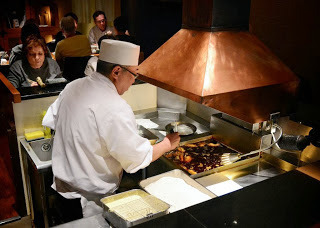
On October 18th, we visited the famous Tsukiji Wholesale Seafood Market in Tokyo (first three photos below), then had a brunch of very fresh sushi in a restaurant right next door (last photo below).




Next we toured the Hama Detached Palace Garden, also called Hamarikyu, (first photo) with its Nakajima teahouse (second photo), a beautiful Eden in the center of Tokyo.


Then we headed for the Ginza district, famous for its high-class shops, such as pearl purveyor Mikimoto (first photo below) and ate a late lunch in a restaurant at the top floor of an interesting building (second photo) with round balconies at each level.


Next stop was the Kabuki-za Theater. It, like most of the temples, shrines, and other monuments we saw, had a display of sake (rice wine) barrels outside (first photo below), representing donations from sake breweries. We saw one act of an all-day, 9-act Kabuki performance at the theater (last two photos below, exterior and interior). The lively act included a swindle and a battle scene, and we rented headphones that played an English commentary during the performance. Unfortunately, no photos of the performance were allowed.



We exited the theater after night had fallen and had our "Lost in Translation" moment (first photo below) while walking through the neon lights of the Ginza district to see the spectacular interior of the Tokyo International Forum (second photo). After dinner in a nearby bakery, we traveled via subway back to the hotel, and it was still crowded with commuters then (last photo).



The next day, October 19th, we went to the plaza outside the Tokyo Imperial Palace to see the statue of Kusunoki Masashige (first photo below), a 14th-century samurai who epitomized the ideal of samurai loyalty. Then we took a group photo (second one below, I'm in the blue raincoat) in front of the Nijubashi Bridge that crosses the moat around the palace.


Next we visited Sensō-ji, the Asakusa Kannon Temple (first photo below), and its ornate altar (second photo). The whole complex teemed with people. As at all Buddhist temples, there was a station where worshippers could cleanse themselves (third photo) and another where they could light incense and pray (fourth photo).




For lunch, our guide took us to the basement food garden of the huge Mitsukoshi department store in the Ginza district, where we shopped for Japanese delicacies, such as salads or Bento boxes (two photos below), to eat for a picnic lunch in the rooftop garden of the store.


Then we went to Meiji Jingu, a Shinto shrine, with a massive tori gate at its entrance (first photo). All Shinto shrines had torii gates at the entrances. Some were painted red and some were left natural colored, like this one. Since it was Saturday, we were able to observe some children being brought in for blessings at ages of 100 days or 3, 5, or 7 years. They were dressed in traditional clothing, like the girl in the second photo below. Also, we observed wedding parties having photos taken and parading into and out of rooms in the temple where the bridal couple was blessed by a Shinto priest (see last two photos below).




Dinner that night was at a tempura restaurant (two photos below). This was our last day in Tokyo. On October 20th, we left on a bus for the mountain resort of Hakone.


Published on December 06, 2013 03:00
December 4, 2013
Japan Trip Report - Part One
In October, my husband Neil and I traveled to Japan on an Overseas Adventure Travel tour. After processing thousands of photos and trying to pick a precious few, I'm finally ready to share some photos and a summary of our adventures here. I'll post reports that each summarize a few days of our two and a half week adventure this week and next. Enjoy!
We left Denver airport on October 14th on one of Boeing's new 787 Dreamliners and arrived at the Tokyo airport 12 hours later on the afternoon of October 15th. After a long bus ride into the city in pouring rain, we checked into the Hotel Monterey Honzomon and met our guide, Michiko Ikeda. She told us a typhoon was attacking the city (the first of three to visit Japan while we were there). We walked a short distance in the rain to a noodle restaurant nearby for a quick dinner before sinking into bed.
We got a late start in our sight-seeing the next day because strong winds were still blowing debris around and some of the subway stations were flooded, affecting the morning commute. By mid-morning, however, we were able to go to the Tokyo National Museum (photo below), the largest museum in Japan, in Ueno Park.
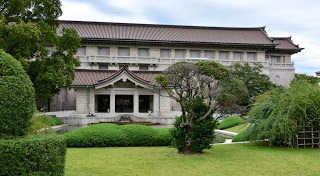
There we saw many examples of their collection of 87,000 historical artifacts and works of art, including the screen, armor and kimono shown below.
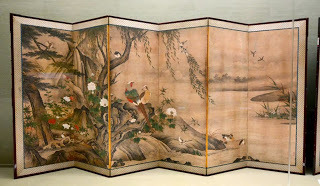
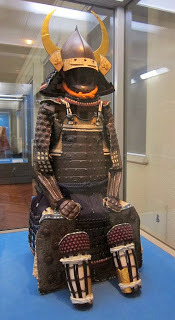
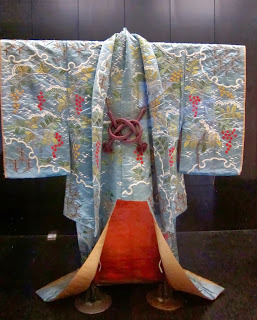
After that we ate lunch at a French restaurant, then walked through the Yanaka district, one of the only areas of Tokyo undamaged during World War II, and home to many traditional wooden houses. There, we visited the workshop of Allan West (first photo below), an American transplant who paints folding screens and other media using traditional Japanese methods and materials. Then we walked through a large Buddhist graveyard (second photo) to the traditional shopping district of Yanaka (third photo). After returning to the hotel, we bought some takeout sushi from a nearby deli, ate it in our room and crashed early, to recover from jet lag.
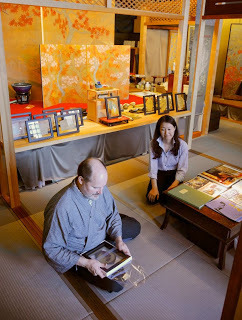
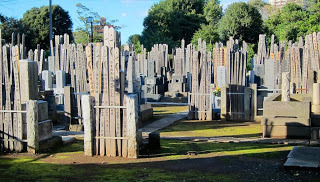
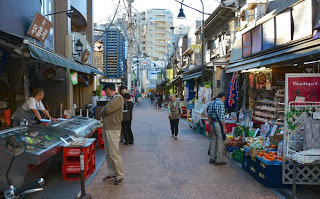
The next day, October 17th was transportation discovery day as we rode the subway (first two photos below--notice all the smartphones in the hands of the passengers), a JR (Japan Railway) train (third photo--the green uniformed men will rush in and clean it in a few minutes before we board), a monorail (fourth photo, from inside), and a local train (fifth photo) to Kamakura.
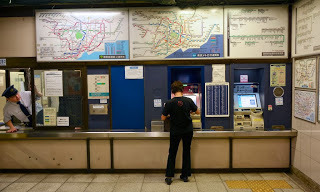
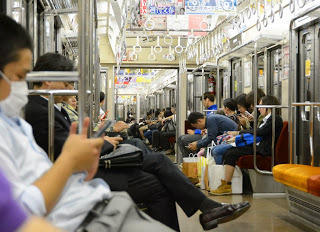
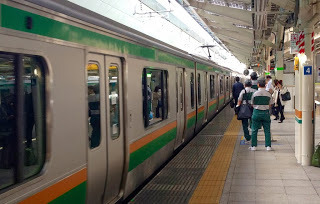
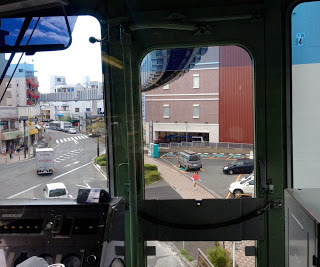
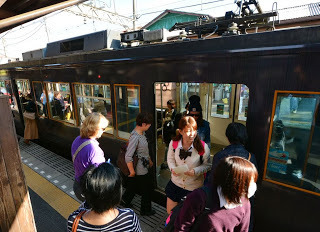
In Kamakura we saw the Daibutsu, a huge bronze image of Buddha that we could go inside (first photo below). While there, Japanese schoolgirls practicing their English came up to me to ask some questions and take a photo (second photo--Neil is making my rabbit ears).
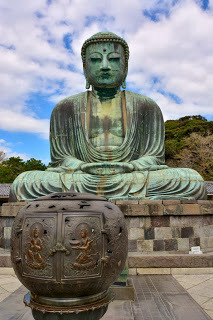
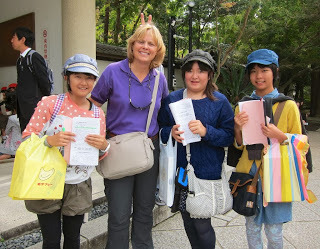
Then we went to the Hase Kannon Temple, famous for its large wooden statue of Kannon, the Goddess of Mercy, and its beautiful garden (first photo below). The temple also houses hundreds of small Jizō statues, placed by parents mourning offspring lost to miscarriage, stillbirth, or abortion (second photo).
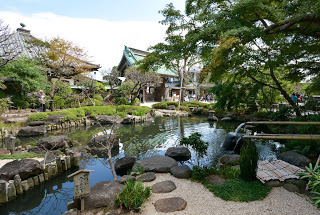
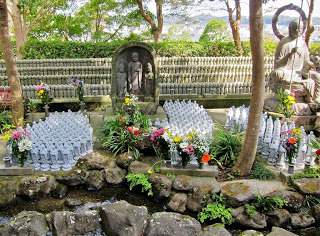
After a beautiful lunch of Japanese specialties (first photo below), we went to the Tsurugaoka Hachiman Shrine (second photo). Then we strolled along the mile-long shopping street leading up to the shrine. ALL of the Buddhist temples and Shinto shrines we visited in Japan had shops lining the approach street, but this was the most extensive shopping district we saw.
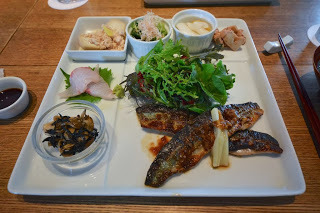
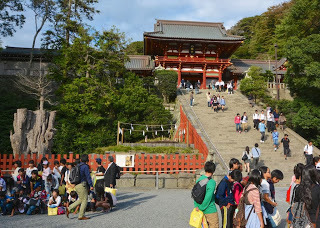
Upon returning to Tokyo, Neil and I broke off from the tour to ride the subway to the Tokyo Sky Tree (first photo), the tallest structure in Japan. We rode the elevator to the top to see the magnificent views (next two photos), then had a late dinner at an egg pancake restaurant (last photo) in its shopping mall where the food cooked in the center of our table.
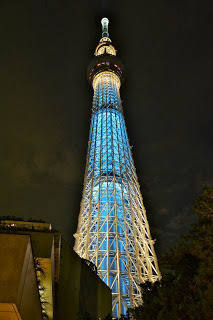
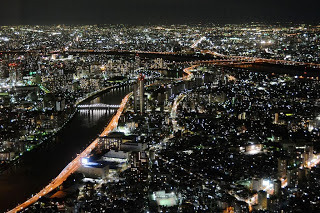
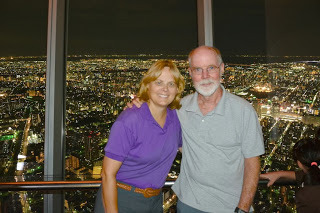
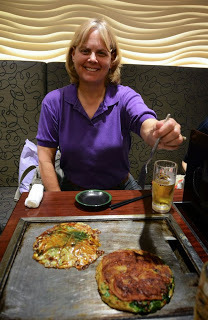
More on Friday!
We left Denver airport on October 14th on one of Boeing's new 787 Dreamliners and arrived at the Tokyo airport 12 hours later on the afternoon of October 15th. After a long bus ride into the city in pouring rain, we checked into the Hotel Monterey Honzomon and met our guide, Michiko Ikeda. She told us a typhoon was attacking the city (the first of three to visit Japan while we were there). We walked a short distance in the rain to a noodle restaurant nearby for a quick dinner before sinking into bed.
We got a late start in our sight-seeing the next day because strong winds were still blowing debris around and some of the subway stations were flooded, affecting the morning commute. By mid-morning, however, we were able to go to the Tokyo National Museum (photo below), the largest museum in Japan, in Ueno Park.

There we saw many examples of their collection of 87,000 historical artifacts and works of art, including the screen, armor and kimono shown below.



After that we ate lunch at a French restaurant, then walked through the Yanaka district, one of the only areas of Tokyo undamaged during World War II, and home to many traditional wooden houses. There, we visited the workshop of Allan West (first photo below), an American transplant who paints folding screens and other media using traditional Japanese methods and materials. Then we walked through a large Buddhist graveyard (second photo) to the traditional shopping district of Yanaka (third photo). After returning to the hotel, we bought some takeout sushi from a nearby deli, ate it in our room and crashed early, to recover from jet lag.



The next day, October 17th was transportation discovery day as we rode the subway (first two photos below--notice all the smartphones in the hands of the passengers), a JR (Japan Railway) train (third photo--the green uniformed men will rush in and clean it in a few minutes before we board), a monorail (fourth photo, from inside), and a local train (fifth photo) to Kamakura.





In Kamakura we saw the Daibutsu, a huge bronze image of Buddha that we could go inside (first photo below). While there, Japanese schoolgirls practicing their English came up to me to ask some questions and take a photo (second photo--Neil is making my rabbit ears).


Then we went to the Hase Kannon Temple, famous for its large wooden statue of Kannon, the Goddess of Mercy, and its beautiful garden (first photo below). The temple also houses hundreds of small Jizō statues, placed by parents mourning offspring lost to miscarriage, stillbirth, or abortion (second photo).


After a beautiful lunch of Japanese specialties (first photo below), we went to the Tsurugaoka Hachiman Shrine (second photo). Then we strolled along the mile-long shopping street leading up to the shrine. ALL of the Buddhist temples and Shinto shrines we visited in Japan had shops lining the approach street, but this was the most extensive shopping district we saw.


Upon returning to Tokyo, Neil and I broke off from the tour to ride the subway to the Tokyo Sky Tree (first photo), the tallest structure in Japan. We rode the elevator to the top to see the magnificent views (next two photos), then had a late dinner at an egg pancake restaurant (last photo) in its shopping mall where the food cooked in the center of our table.




More on Friday!
Published on December 04, 2013 03:00
November 29, 2013
Sunday Signing in Breckenridge and a 5-Star Review!
Along with my two appearances on Saturday in Monument, Colorado, and Glendale, Colorado tomorrow (see post below), I will be signing copies of my latest release,
A Basket of Trouble
, and my other books, at The French Kiss boutique in Breckenridge, Colorado on Sunday. I'll also be handing out my sleuth Claire Hanover's "Tips for Making Perfect Gift Baskets." The full details are:
Sunday, December 1, 2013, Noon – 2PM
Signing by Local Mystery Author Beth Groundwater
The French Kiss
226 South Main Street, Breckenridge, CO 80424
And, I just received a wonderful 5-star review for A Basket of Trouble from Lori Caswell on her Escape With Dollycas Into A Good Book blog. Read it HERE!
Sunday, December 1, 2013, Noon – 2PM
Signing by Local Mystery Author Beth Groundwater
The French Kiss
226 South Main Street, Breckenridge, CO 80424
And, I just received a wonderful 5-star review for A Basket of Trouble from Lori Caswell on her Escape With Dollycas Into A Good Book blog. Read it HERE!
Published on November 29, 2013 03:00
November 28, 2013
Happy Thanksgiving!
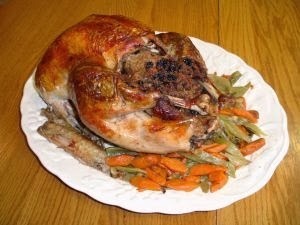
Thanksgiving is a time for stepping way from the hubbub of everyday life to celebrate all that we have to be grateful for with family and friends. I'm grateful for my family and friends, my health, financial security, and being lucky enough to live in the United States of America. I'm also grateful for my ability to write mystery novels and for the readers who read those novels and tell me how much they enjoy them.
My husband is always grateful for the pumpkin pie. What are you grateful for?
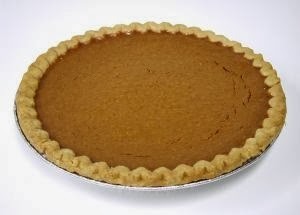
I wish all of my blog readers a Happy Thanksgiving and many blessings for which you can be grateful!
Published on November 28, 2013 03:00

